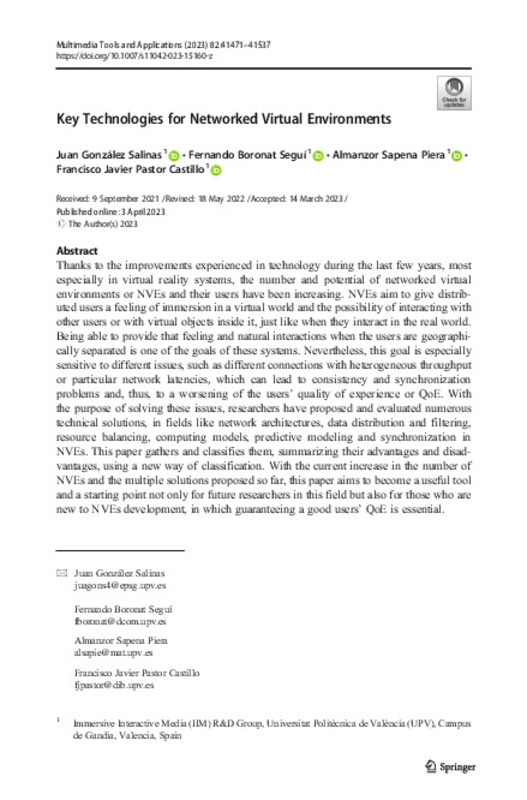JavaScript is disabled for your browser. Some features of this site may not work without it.
Buscar en RiuNet
Listar
Mi cuenta
Estadísticas
Ayuda RiuNet
Admin. UPV
Key Technologies for Networked Virtual Environments
Mostrar el registro sencillo del ítem
Ficheros en el ítem
| dc.contributor.author | González-Salinas, Juan
|
es_ES |
| dc.contributor.author | Boronat, Fernando
|
es_ES |
| dc.contributor.author | Sapena Piera, Almanzor
|
es_ES |
| dc.contributor.author | Pastor, J.
|
es_ES |
| dc.date.accessioned | 2024-03-08T11:18:27Z | |
| dc.date.available | 2024-03-08T11:18:27Z | |
| dc.date.issued | 2023-11 | es_ES |
| dc.identifier.issn | 1380-7501 | es_ES |
| dc.identifier.uri | http://hdl.handle.net/10251/202996 | |
| dc.description.abstract | [EN] Thanks to the improvements experienced in technology during the last few years, most especially in virtual reality systems, the number and potential of networked virtual environments or NVEs and their users have been increasing. NVEs aim to give distributed users a feeling of immersion in a virtual world and the possibility of interacting with other users or with virtual objects inside it, just like when they interact in the real world. Being able to provide that feeling and natural interactions when the users are geographically separated is one of the goals of these systems. Nevertheless, this goal is especially sensitive to different issues, such as different connections with heterogeneous throughput or particular network latencies, which can lead to consistency and synchronization problems and, thus, to a worsening of the users' quality of experience or QoE. With the purpose of solving these issues, researchers have proposed and evaluated numerous technical solutions, in fields like network architectures, data distribution and filtering, resource balancing, computing models, predictive modeling and synchronization in NVEs. This paper gathers and classifies them, summarizing their advantages and disadvantages, using a new way of classification. With the current increase in the number of NVEs and the multiple solutions proposed so far, this paper aims to become a useful tool and a starting point not only for future researchers in this field but also for those who are new to NVEs development, in which guaranteeing a good users' QoE is essential. | es_ES |
| dc.description.sponsorship | Open Access funding provided thanks to the CRUE-CSIC agreement with Springer Nature. This work was supported, in part, by Grants PEJ2018-003875-A-A and PID2021-126645OB-I00, funded by MCIN/AEI/10.13039/501100011033 and by "ERDF A way of making Europe". It was also supported, in part, by ACIF/2021/192 from"Programa I+D+i de la Generalitat Valenciana". | es_ES |
| dc.language | Inglés | es_ES |
| dc.publisher | Springer-Verlag | es_ES |
| dc.relation.ispartof | Multimedia Tools and Applications | es_ES |
| dc.rights | Reconocimiento (by) | es_ES |
| dc.subject | Computing models | es_ES |
| dc.subject | Data distribution | es_ES |
| dc.subject | Data filtering | es_ES |
| dc.subject | Networked virtual environment | es_ES |
| dc.subject | Predictive modeling | es_ES |
| dc.subject | Resource balancing | es_ES |
| dc.subject | Synchronization | es_ES |
| dc.subject.classification | MATEMATICA APLICADA | es_ES |
| dc.subject.classification | INGENIERÍA TELEMÁTICA | es_ES |
| dc.subject.classification | DIBUJO | es_ES |
| dc.title | Key Technologies for Networked Virtual Environments | es_ES |
| dc.type | Artículo | es_ES |
| dc.identifier.doi | 10.1007/s11042-023-15160-z | es_ES |
| dc.relation.projectID | info:eu-repo/grantAgreement/AEI/Plan Estatal de Investigación Científica y Técnica y de Innovación 2021-2023/PID2021-126645OB-I00/ES/SINCRONIZACION HIBRIDA PARA POSIBILITAR NUEVOS SERVICIOS DE TV HIBRIDA INTERACTIVOS, INMERSIVOS, ACCESIBLES Y PERSONALIZABLES EN ENTORNOS MULTI-DISPOSITIVO Y MULTI-USUARIO/ | es_ES |
| dc.relation.projectID | info:eu-repo/grantAgreement/GENERALITAT VALENCIANA//CIAICO%2F2022%2F025//DISEÑO Y EVALUACION DE SOLUCIONES PROACTIVAS DE SINCRONIZACION INTELIGENTE PARA FACILITAR SERVICIOS INTERACTIVOS, ACCESIBLES, INMERSIVOS Y PERSONALIZADOS EN ENTORNOS DE TV MULTI-DISPOSITIVO Y MULTI-USUARIO/ | es_ES |
| dc.relation.projectID | info:eu-repo/grantAgreement/GVA//ACIF%2F2021%2F192/ | es_ES |
| dc.relation.projectID | info:eu-repo/grantAgreement/AEI//PEJ2018-003875-A-A/ | es_ES |
| dc.rights.accessRights | Abierto | es_ES |
| dc.contributor.affiliation | Universitat Politècnica de València. Departamento de Comunicaciones - Departament de Comunicacions | es_ES |
| dc.contributor.affiliation | Universitat Politècnica de València. Escuela Politécnica Superior de Gandia - Escola Politècnica Superior de Gandia | es_ES |
| dc.description.bibliographicCitation | González-Salinas, J.; Boronat, F.; Sapena Piera, A.; Pastor, J. (2023). Key Technologies for Networked Virtual Environments. Multimedia Tools and Applications. 82(27):41471-41537. https://doi.org/10.1007/s11042-023-15160-z | es_ES |
| dc.description.accrualMethod | S | es_ES |
| dc.relation.publisherversion | https://doi.org/10.1007/s11042-023-15160-z | es_ES |
| dc.description.upvformatpinicio | 41471 | es_ES |
| dc.description.upvformatpfin | 41537 | es_ES |
| dc.type.version | info:eu-repo/semantics/publishedVersion | es_ES |
| dc.description.volume | 82 | es_ES |
| dc.description.issue | 27 | es_ES |
| dc.relation.pasarela | S\510559 | es_ES |
| dc.contributor.funder | GENERALITAT VALENCIANA | es_ES |
| dc.contributor.funder | Agencia Estatal de Investigación | es_ES |
| dc.contributor.funder | European Regional Development Fund | es_ES |
| dc.contributor.funder | Universitat Politècnica de València | es_ES |








